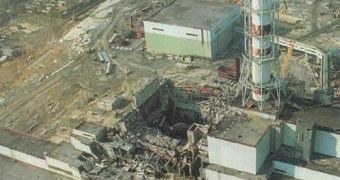Speaking at the annual meeting of the American Geophysical Union (AGU) on Monday, experts revealed a troublesome fact about Chernobyl, the Ukrainian nuclear power plant that blew up in 1986. Recent measurements in the exclusion zone, where no humans can go without protective equipment, have revealed that the radioactive material that was spilled in the area was nowhere near the decay level that was predicted for it. In other words, the scientists are saying that it will take a lot more time for the land to be cleansed than originally believed, Wired reports.
Previous estimates, based on the fact that the Cesium 137's half-life is 30 years, estimated that the restriction zone could be lifted, and then re-inhabited soon. But experiments reveal that the radioactive material is not decaying as fast as predicted, and scientists have no clue as to why this is happening. The April 26, 1986 accident was the largest nuclear accident in the world, and only a level 7 event on the International Nuclear Event Scale. Its fallout was made worse by the Soviet Union's attempt at covering up the incident, which saw a lot of people exposed to lethal doses of radiations.
“Normally you’d say that every 30 years, it’s half as bad as it was. But it’s not. It’s going to be longer before they repopulate the area,” Savannah River National Laboratory nuclear scientist Tim Jannick, who has also collaborated in the new investigation, said at the AGU conference. The new estimates point out that the half-life for ecological Cesium 137, the variety out in the open, is between 180 and 320 years. This pours a stream of cold water on the Ukrainian authorities' plans to start reusing the land.
“I have been involved in Chernobyl studies for many years and this particular study could be of great importance to many [Department of Energy] researchers,” Lawrence Berkeley National Laboratory (Berkeley Lab) nuclear remediation expert Boris Faybishenko says. In the greater scheme of things, the fallout and nuclear disaster provided researchers with a window of opportunity into studying the possible effects of radiation poisoning on the environment and ecosystems. For the past 20 years, teams have been analyzing how strontium, plutonium and cesium isotopes infiltrate the ground around Chernobyl several times annually.

 14 DAY TRIAL //
14 DAY TRIAL //